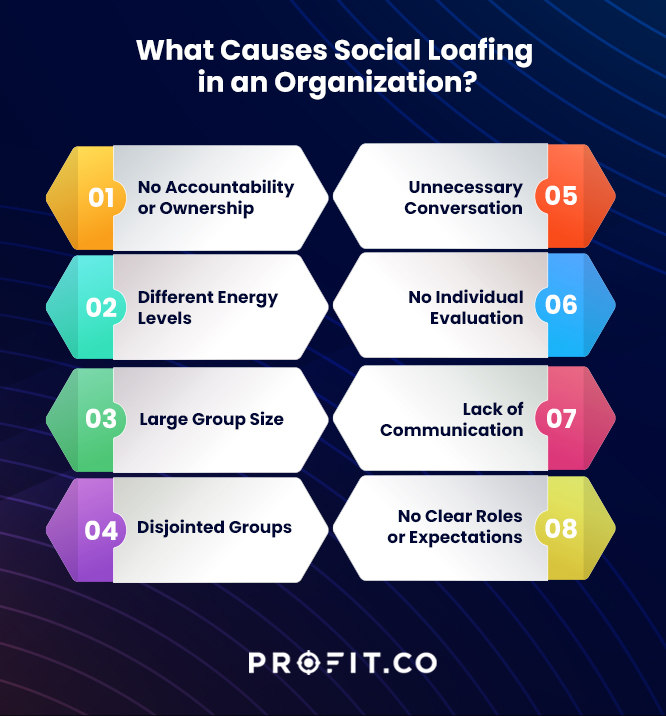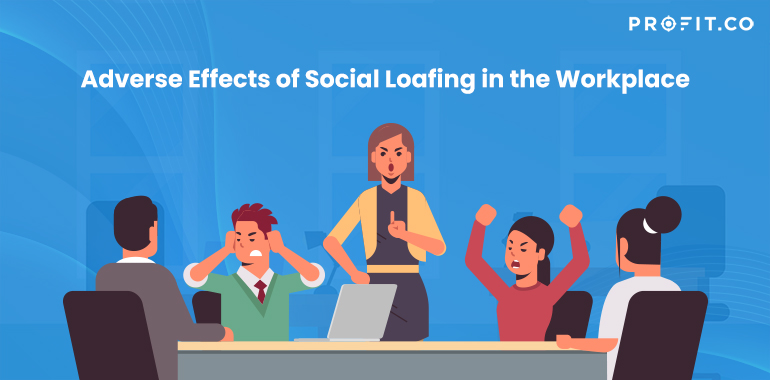Introduction
Collaboration is the lifeblood of every successful business, but nearly four in 10 employees say it’s lacking in their organizations. Working in a group setting gives rise to social loafing, a phenomenon that decreases a team’s motivation and productivity. Social loafing begins early in life and has severe implications in the workplace.
This guide explores
- What Is Social Loafing?
- What causes Social loafing?
- How To Avoid Social Loafing and Improve Team Work?
What Is Social Loafing?
Social loafing is a behavior that affects group dynamics where team members become less productive than when working independently. Team members feel less motivated to contribute to the group’s goals, choosing instead to pass their responsibilities onto others in the group.
Social Loafing Theory
The concept of social loafing goes back to 1913 when French engineer Maximilian Ringelmann observed a tug-of-war. He discovered that individuals pulled harder on the rope than when groups challenged each other.
Similar experiments over the years revealed the same tendency, which is why social loafing is known as the Ringelmann effect. It implies that subconsciously, people lose motivation in group tasks where there’s no clear way to evaluate their contributions.
In addition, a social loafing scale is a valuable tool to evaluate this effect in a team. It features five elements that you can rate to understand your team’s performance:
- A decrease in the team member’s motivation during a group activity
- A general passive attitude in team members
- Greater responsibilities for individual group members
- Free-riding (joining or shifting their duties to others)
- A decreased awareness of how group members evaluate individual performance
Being productive gives people a sense of satisfaction and fulfillment that loafing never can.
Two Common Types of Social Loafing
Social loafing can manifest in various ways, adversely affecting your company’s productivity. The two main types of social loafing are the free rider effect and the sucker effect.
In the free rider effect, team members show a casual attitude towards the group activity and contribute less to varying degrees. Other group members must work harder to fill this productivity gap. Each member who offers less to the group and triggers this productivity imbalance is a free rider.
Consequently, the top-performing team members feel like the free riders are taking advantage of their efforts. This leads to the sucker effect, where top performers also stop contributing and become underperformers.
Where the free rider effect causes a productivity imbalance, the sucker effect leads to a massive decline in the group’s performance. The sucker effect drags the entire team down because neither the good performance nor the free riders engage in the group tasks.
The Objective and Key Results are a simple goal management platform where the objective can be defined between three and five measurable key results. If these outcomes are achieved, the objective is successful. Team performance can be monitored and managers can keep track through the OKR dashboard.
Book a free demo with our team to learn more about how OKR software can optimize your team’s performance!

What Causes Social Loafing?
Several factors contribute to social loafing in the workplace, as explained below:
- No Accountability or Ownership
We perform better on individual tasks because there’s a high level of responsibility for our outcomes and more significant repercussions should we fail. In a group setting, however, we feel less accountable or responsible for our actions because of shared group credit. We end up feeling less motivated to perform exceptionally or meet a deadline for the group task.
- No Clear Roles or Expectations
We often assume that other group members will handle the essential tasks if roles aren’t clearly assigned. This means we avoid those necessary tasks until the last minute when the group project is due.
- No Individual Evaluation
We put less effort into our tasks if there are no metrics to capture our contribution to the group’s success. For example, if the sales team’s conversion rates matter more than each salesperson’s numbers, there’s a higher likelihood of underperformance.
- Unnecessary Conversation
We all enjoy having our coworkers as friends, but it may lead to social loafing when undertaking group tasks. If we spend too much time discussing unrelated topics, we may assume others will handle the “real work” or lose focus on our tasks.
- Difference in Energy Levels
Highly motivated individuals may shift gears in a group setting when they see others putting less effort into the project. This is a subconscious need for fairness in teamwork, meaning that we’d rather lower our effort than motivate low performers in the group.
- Large Group Size
Social loafing increases with the number of group members since individuals have fewer chances of visibility. We dodge responsibility, spend more time chatting with colleagues, and contribute as little as possible when we can disappear in a large group.
- Lack of Communication
In many cases, group settings make us less confident about speaking up, asking questions, or offering ideas. Social loafing occurs when there are no opportunities for team members to communicate effectively and contribute to the project.
- Disjointed Groups
Some groups simply don’t gel due to personality differences and negative assumptions. We experience social loafing if some group members assume that others won’t perform; therefore, we refuse to take up our fair share of the work.
Impact of Social Loafing at Workplace
There are numerous effects of social loafing on group performance that negatively impact a business. For example, tensions can arise between performers and non-performers in the group, as well as feelings of exploitation for group members who put in more effort than others.
Other impacts of social loafing in the workplace include:
- Decreased productivity as team members put in less effort in the group tasks
- Lack of attention in virtual teams because there’s little supervision over their group tasks
- Resentment, frustration, and conflicts between team members
- Decreased motivation for future group activities
- Burnout for team members who carry the most weight in group projects
- High turnover as burnt-out employees opt for a better workplace
Social Loafing Examples
Here are some social loafing examples in various real-world settings:
- Tug-of-War
As mentioned earlier, the first instance of social loafing was at a tug-of-war game. Whether in a kindergarten or a corporate team-building event, the result is the same: the more people you add to pull the rope, the less effort each person will put into it.
- School Assignments
Group homework projects are notoriously prone to social loafing. The student who values their performance works harder in group assignments, and the rest of the group benefits from the grade.
- Team Sports
Star players often carry the rest of the team because of their goal-scoring ability. Other team members focus on passing the ball to the star or disengaging entirely from the game.
- Brainstorming Sessions
Social loafing can appear during brainstorming if only one or two people come up with all the ideas while the rest agree. This often happens in organizations where employees get shot down for expressing their views or where managers take all the credit for group projects.
- Virtual Meetings
A Zoom meeting of 50 or 100 members makes it easy for individuals to turn off their cameras, mute their microphones, and do other activities. We have fewer opportunities for social loafing when there are ten or fewer people in virtual meetings.
How To Avoid Social Loafing
The antidote to social loafing is to provide clarity in collaborative tasks. Be clear on who does what tasks, and use work management software to prioritize and track all ongoing projects.
Communicate how group tasks contribute to the business goals and objectives, and recognize every contribution appropriately. You can also automate manual processes like seeking approvals or data entry so that your team can focus on meaningful tasks in group projects.
How Can Organizations Address Social Loafing?
Social loafing is a natural human tendency, but its impacts can cripple collaboration in organizations. Here’s how to reduce social loafing in the workplace:
- Don’t Let Your Team Self-Regulate
Managers want to see the best in their teams, trusting they have the proper training and experience to do what is necessary. Unfortunately, this attitude breeds social loafing. Instead, clearly outline all the tasks required for the group project and assign a workflow for each team member. This way, everyone is accountable for their part in the project, and there’s no chance of team members passing their responsibilities onto others. Employees thrive on this type of management rather than leaving them to figure things out on their own.
- Assign A Project Manager
A project manager ensures that all tasks are accounted for and offers transparency in group activities. In addition, a project manager is in an excellent position to identify top performers, motivate underperformers, and give guidance when challenges arise. Give the roles and responsibilities of a project manager to a team member to boost the group’s motivation.
- Work with Small Groups
Break down large groups into smaller ones to reduce social loafing in the workplace. These sub-groups make team members accountable for their tasks and encourage better collaboration.
It’s also easier to recognize individual contributions when they work in smaller groups, which increases motivation. Design collaborative tasks where team members work in pairs, each contributing to the larger group. This approach allows team members to keep their energy high throughout the project and encourage each other to overcome challenges.
- Supervise Your Groups
Check-in with your team members regularly to ensure everyone meets their obligations and contributes fairly to the project. Establish the appropriate performance metrics and reward milestones as your group works towards the project’s completion and delivery.
- Reward Team Members Individually
There are many opportunities within group projects to recognize and reward individual contributions. For example, you can acknowledge members who accomplish challenging tasks, offer creative solutions, or help others achieve their goals within the group.
Individual employee recognition improves morale and encourages every team member to do their best for the group’s success.
FAQs
- What is social loafing?
Social loafing is a behavior that causes people to perform poorly when working in groups.
- What is an example of social loafing?
An example of social loafing is a school group assignment, where one student does all the work, but the whole group gets the grade.
- What are the types of social loafing?
The two types of social loafing are the free rider effect and the sucker effect. Both types of social loafing lead to drastic underperformance in group tasks in the workplace.
- What causes social loafing?
Social loafing arises due to a lack of motivation, large group sizes, and no individual recognition for group contributions.
- What is the effect of social loafing in the workplace?
Social loafing in the workplace leads to high turnover, conflicts among team members, lack of attention during virtual meetings, and a low probability of group project success in the future.
Conclusion
Social loafing has far-reaching negative consequences for collaborative projects. Managers must know how to reduce social loafing in the workplace by limiting team sizes, monitoring project tasks, and recognizing individual contributions. Once you address the effects of social loafing in group performance, you’ll see a boost in employee loyalty, productivity, and project success. You can get started on Profit.co completely free today to learn how OKRs can help align and track your team effectively.

